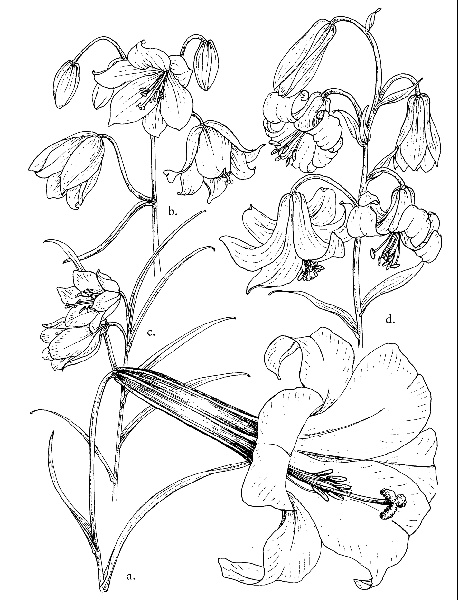About 100 species of bulbous perennials from the northern temperate zone and south to the Philippines. They are characterised by their loosely scaly bulbs (lacking a protective covering as in Narcissus) and leafy erect stems bearing one to several flowers. The latter can be trumpet-shaped or fashioned like a Turk's cap, the six tepals rolled back.
In general, lilies are not thought of as rock garden plants and most are too tall anyway. Those described here can be placed very effectively on the large rock garden or raised bed. They can also be potted and make fine specimens for the alpine house. Well drained but not dry, humus-rich soil is needed, and some lime is tolerated by most species. A site in partial sun must be provided and many lilies grow well in full sun if their root area is shaded by low plants to keep the soil cool. Propagation by seed provides the healthiest plants, but offsets and stem bulbils can be used, and scales removed from mature bulbs in autumn or winter. Lily seeds have two main modes of germination. In group one, a grassy leaf appears soon after germination and the young plants grow steadily (epigeal germination). In group two, a root and a tiny bulb forms but no top growth appears until a cool period (normally winter) is experienced. Then, as the weather warms again (spring) foliage emerges and the plantlets grow on (hypogeal germination). Seed of the latter group should be sown in early autumn in warmth to initiate germination. As soon as small bulbs form, the pots and pans are placed in a cold frame. This process can be speeded up by mixing the dry seed with moist peat, sand or vermiculite and placing in a plastic bag at 18°C. As soon as tiny bulbs are visible, the bag is put in a refrigerator at not more than 6°C. for six weeks. The tiny bulbs are then sown in potting compost and kept in a minimum temperature. Lilies can suffer from botrytis (grey mould), virus and aphids so a watch should be kept for these troubles. Aphids spread viruses which are generally lethal, so keeping these pests under control is important.

a, L. formosanum; b, L. mackliniae; c, L. nanum; d, L. pomponium;
Sign up for our newsletter to receive our monthly update direct to your inbox. Featuring our latest articles and news.
Built by Atomic Smash

